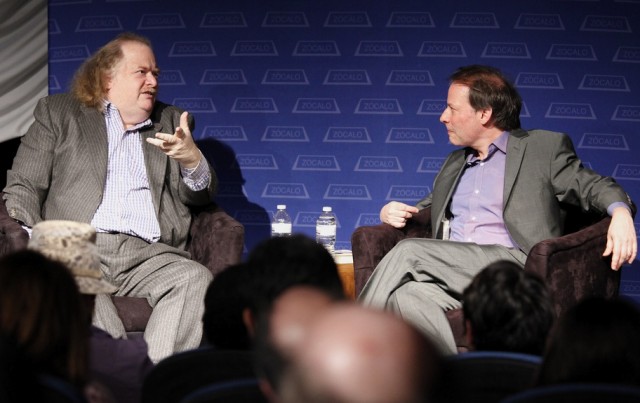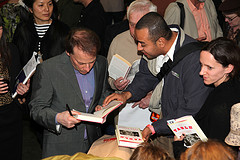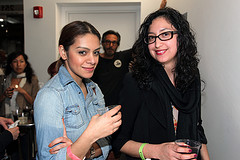
Adam Gopnik’s defense of molecular gastronomy is simple. “I love magic tricks,” he said. “You know it’s a trick; you know it’s not magic. But the very fact of doing it fascinates me, and the experience of pleasure I think is quite stirring.” For Gopnik, staff writer for the The New Yorker and author of The Table Comes First: Family, France, and the Meaning of Food. dining is about “spectacle and surprise”–which is why the work of a chef like El Bulli’s Ferran Adrià, a pioneer in molecular gastronomy whose creations include a gorgonzola cheese volleyball, is valuable. His food, said Gopnik, “takes the idea of the restaurant as theater, the restaurant as entertainment, the restaurant as magic show as far as it can go.”
The opening question of the event, which was co-presented by Kaiser Permanente, was “Foodies: what, if anything, are they good for?” The answer, Gopnik and food critic Jonathan Gold agreed, is the pleasure dining together can bring us–provided that we don’t take what’s on our plates too seriously, and recognize theater and magic tricks for what they are.
Americans, for instance, treat the systematization and rules of French cooking very earnestly (Robert Parker’s wine ratings are a good example), Gopnik told the standing-room-only crowd at the Downtown Independent Theater. But in France there’s an ironic, tongue-in-cheek aspect to a lot of it. The French don’t abide by the rules to the letter. “It’s more a commitment than a performance,” said Gopnik.

The rules of wine pairing have also relaxed over time, said Gold. Before the 1980s, an elaborate tasting meal would involve pairing each course with the appropriate wine. But suddenly, “caring about the wine you drink became a sign that your priorities were in the wrong place.” At new restaurants today, foodstuffs often defy matching with any grape at all.
It’s an example of how tastes change with the times. Wines were sweeter in the past, with less of an emphasis on aging. “The idea that sugar is located at the end of the meal is a very modern idea,” said Gopnik. In the 17th century, sweet tastes were distributed throughout the meal, and that’s being revived at a few rare places like El Bulli.
Gold feels that there’s something about Adrià’s food at El Bulli that’s “against the idea of nourishment, the idea of a meal as a meal.” That gorgonzola volleyball? “Realistically, if he had just given me a piece of cheese, I would’ve just eaten it, and it would’ve tasted better,” he said. For Gopnik, though, that’s not the point. It’s the pleasure of the spectacle. And the good thing about foodie-ism is that it encourages us to be unashamed of that pleasure.
Still, Gopnik averred, there’s a danger in people focusing too much on the food–replacing conversation with sensation. “The reason we really care about food is that it’s the provocateur of human exchanges, human conversation,” he said. There’s also an element of absurdity in writing and talking about food seriously. “One of the things that’s tricky is that you need some sort of ironic detachment in order to write about [food] properly,” said Gopnik. In the middle of a conversation extolling the virtues of a nice meal in Paris, his eight-year-old daughter made an astute observation: “And tomorrow we’ll all be hungry again.” It’s true–and it’s not the sort of comment someone would make after a Wagner opera, for instance.

Where food does resemble opera, Gold argued, is in creating human bonds. When you see the Ring cycle, you become a part of a Wagnerian cult–a community even. And food can do the same thing–like the cult of innards that’s developed among people who “are gung-ho about eating every part of the animal.” And that new community of innard lovers has a downright philosophical basis. It’s about ethics, and how if we’re going to eat animals, we need to respect animals. “There’s a narrative at play,” said Gold. “The foods that you’re eating tell a story that’s not necessarily about themselves.”
Gopnik largely agreed with this. “With all of its absurdities and all of its tribalism and all of the affectations that it promotes and accepts,” Gold said, food orientation also connects us. “The kitchen table is the treaty table of contemporary life.” It’s where you can make scrambled eggs for your kids at midnight, and your son can break big news: “Dad, I think I’m not going to go to college,” or “Dad I’m gay.” Said Gopnik, “That happens more often over the kitchen table than anywhere else.”
In the question-and-answer session, an audience member asked the speakers to address issues of class and culture and to move beyond the realm of haute cuisine.
Gopnik said that criticizing people for talking about molecular gastronomy when there are more serious food issues at stake “is like asking, ‘How can you talk about poetry when we have a literacy problem?’” He doesn’t think there’s “a built-in conflict between talking about the highest expression of a higher pursuit, and trying to broaden people’s perspective.”

“It doesn’t mean that that incredibly great bowl of Thai noodles you’re eating tomorrow night is lesser,” added Gold.
In response to a question about whether sustainability biases them toward a particular restaurant, Gopnik and Gold agreed that the food comes first.
“You have to be able to cook as well as to source,” said Gold, citing a New York restaurant where everything was fresh and local–but not very good. “It was a perfect restaurant except for the food.”
Gopnik feels that there’s value in knowing where your food comes from–it makes us healthier people. But that’s not the best argument for eating sustainably. “The argument for pleasure and soulfulness is always going to be more powerful than the argument for necessity,” he said.
Watch full video here.
See more photos here.
Buy the book: Skylight Books, Amazon, Powell’s.
Read food notables’ opinions on what we should miss about pre-foodie culture here.
Read more from Kaiser Permanente on food and cooking here.
*Photos by Aaron Salcido.




Send A Letter To the Editors